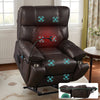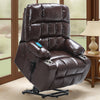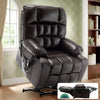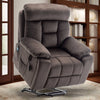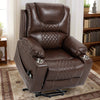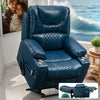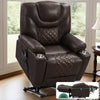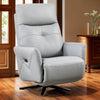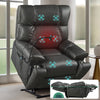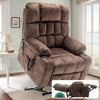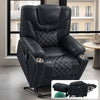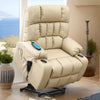Understanding Medicare Coverage for Lift Chairs
What Medicare Covers in Lift Chairs
Medicare's scope for lift chairs primarily includes the cost of the seat lifting mechanism, which is the vital component enabling the chair to assist users in standing up. The coverage does not extend to the whole recliner chair itself but focuses on this essential part, categorized as durable medical equipment (DME). To be eligible for this benefit, the lift mechanism must be an integral part of the chair's design. It's essential to note that if the chair has additional features such as massage functions or heating pads, Medicare will not cover those costs, as they are considered non-essential enhancements.
Qualifying for Medicare Coverage
To qualify for Medicare coverage of a lift chair, you must meet certain medical criteria. Initially, you need a doctor's prescription stating that the chair is necessary due to a specific medical condition that affects your ability to stand up from a seated position. Conditions such as severe arthritis or other balance or mobility issues are some common reasons a lift chair may be prescribed. Additionally, you must be able to operate the chair independently or with assistance from someone else. The chair must also be considered as part of your treatment plan and expected to improve your condition or prevent it from worsening. To finalize coverage, the prescription must also come from a doctor enrolled in Medicare, ensuring they meet Medicare's standards for prescribing such equipment.
Exploring the Benefits of Recliner Lift Chairs
The Mechanism of Recliner Lift Chairs
Recliner lift chairs are designed to aid individuals who have difficulty transitioning from a seated position to standing up. At the core of these chairs is a powerful lifting system. This system is usually composed of a metal frame powered by an electric motor. When activated, the frame tilts the chair forward, raising the seat and helping the user to stand up with ease. This mechanism is not only helpful for those with mobility issues but also reduces strain on the back and knees, supporting a smoother and safer rise.
Advantages of Dark Blue Recliner Chairs
Recliner lift chairs offer numerous benefits, enhancing comfort and mobility for their users. Specifically, dark blue recliner chairs come with their own set of advantages. First and foremost, dark blue is a color that easily blends with a variety of decor styles, making it a versatile choice for any home. It's also known for its calming properties, creating a tranquil atmosphere wherever it's placed. On a practical note, dark blue fabric can effectively hide stains and wear, ensuring that the chair maintains its appealing look for years to come. Moreover, dark blue does not show pet hair as much as lighter-colored fabrics, which is a plus for pet owners. The color choice is not only about aesthetics; dark blue can also have a higher resale value due to its popular demand. It's important to note that while Medicare may cover the lift mechanism, it does not cover the cost based on color preferences, including dark blue. However, owning a chair that meets both your functional needs and style preferences can greatly enhance your quality of life.
Steps to Obtain a Medicare-Covered Lift Chair
Documentation and Prescription Requirements
To acquire a Medicare-covered lift chair, certain documentation and prescription requirements must be fulfilled. Firstly, your doctor must verify that due to a specific medical condition, you need the chair for mobility purposes. The documentation should include a detailed prescription stating the necessity of the lift chair for standing up due to limited mobility. Additionally, your doctor must provide a certificate of medical necessity (CMN), which indicates that you have been assessed and deemed in need of a lift mechanism. Before applying, ensure you have been seen by the prescribing doctor within the last six months. This documentation is critical to prove that the lift mechanism is a medical necessity and not merely for comfort or convenience. It is important to keep all records organized and accessible for when you submit your Medicare claim.
The Process of Filing a Medicare Claim
To file a Medicare claim for a lift chair, follow these steps:
- Obtain a Prescription: After your doctor deems the lift chair medically necessary, get a written prescription.
- Choose a Supplier: Select a supplier that is approved by Medicare to ensure the lift mechanism is covered.
- Purchase the Chair: Purchase the lifting mechanism portion of the recliner chair. Remember, Medicare does not cover the full cost of the chair.
- Submit the Claim: Provide Medicare with the doctor's prescription, your detailed written order, and the receipt from the supplier.
- Wait for Approval: Medicare will review your claim, and if approved, they will reimburse you for the Medicare-approved amount for the seat lift mechanism.
Keep copies of all documents for your records. It may take some time for the claim to be processed, so patience is important. If your claim is denied, you have the right to appeal the decision. For further assistance, you can contact a Medicare representative or a local senior support agency.
Types of Lift Chairs Covered by Medicare
Features of Covered Lift Chairs
Medicare focuses on covering the most critical component of recliner lift chairs: the seat lifting mechanism. This essential feature is what qualifies the equipment as durable medical equipment (DME), which is eligible for coverage. The lift mechanism must be incorporated into the chair's design and be the part that aids the user in sitting down and standing up. Chairs covered by Medicare generally need to have a power lift that can tilt the chair forward, assisting the user to a standing position. It’s vital to ensure that the chair's construction and the lifting system meet Medicare's sturdy and reliable standards. Additional comfort features, such as adjustable backrests or heated seat options, are typically not covered but may enhance the user experience if chosen at the customer's expense.
Limitations and Exclusions in Medicare Coverage
When it comes to Medicare coverage for lift chairs, it's crucial to understand the limitations and exclusions that apply. Medicare will not cover the entirety of a lift chair. Instead, the coverage is specifically for the seat lifting mechanism, which is the component that assists users in standing up from the chair. This means the rest of the chair, such as the upholstery, frame, and non-mechanical features, are not included in the coverage. Additionally, chairs that feature spring-loaded mechanisms are not covered, as Medicare only covers motorized versions. It's also important to note that Medicare will not provide coverage if the lift chair is intended for convenience rather than a medical necessity. To avoid unnecessary costs, ensure you are clear on what Medicare covers before making a purchase, and consult with a healthcare provider about your specific medical needs and the requirements for coverage.
Financial Considerations for Lift Chair Buyers
Cost-Sharing and Out-of-Pocket Expenses
When buying a lift chair, it's important to understand the financial obligations that come with it. Medicare may cover the cost of the lifting mechanism, but not the entire chair. This means that a portion of the expense, known as cost-sharing, is your responsibility. Typically, you'd be required to meet your deductibles and then pay 20% of the Medicare-approved amount if you have met your Part B deductible. Besides the cost-sharing aspect, there are also out-of-pocket expenses to consider. These can include the remaining cost of the chair, delivery fees, additional features not covered by Medicare, and maintenance costs. It's crucial to budget for these expenses to avoid unexpected financial strain.
Tips for Finding Affordable Recliner Lift Chairs
When searching for an affordable dark blue recliner lift chair, buyers should consider several money-saving tips. Firstly, it is essential to shop around and compare prices from different suppliers as costs can vary significantly. Look for sales or discount events at furniture stores or online marketplaces, which may offer the best deals. Purchasing a recliner lift chair during off-peak seasons can also potentially lead to lower prices.
Secondly, consider buying a gently used or refurbished lift chair, which can be much cheaper than a brand new one without compromising quality. Make sure to check the warranty and return policy when opting for this approach. Additionally, some medical supply stores may have rental options, providing a cost-effective solution for those who need a lift chair on a temporary basis.
Lastly, inquire about financing options or payment plans. Many retailers offer these services, allowing buyers to pay for their lift chair in installments. Always check the terms and conditions to ensure the payment plan is manageable and doesn't include hidden fees. By employing these tips, lift chair buyers can make a more economical purchase and enjoy the comfort and assistance that a recliner lift chair provides.
Alternative Funding Options for Recliner Lift Chairs
Medicaid and Other Insurance Plans
While Medicare provides coverage for the mechanical lifting component of a lift chair, it is essential to explore other funding options for purchasing the full chair. Medicaid can serve as a supplemental insurance plan and may offer additional benefits depending on your state's policies. To understand what Medicaid covers, it's important to check with your state's program regarding eligibility and the extent of coverage for durable medical equipment like lift chairs. Besides Medicaid, other private insurance plans may offer partial or full coverage for these chairs. Always review your policy or contact your insurer to confirm what is included in your plan. These alternative insurance plans could significantly reduce your out-of-pocket expenses for a dark blue recliner lift chair.
Community and Non-Profit Resources
While Medicare may provide assistance with covering the cost of the lifting mechanism in a recliner lift chair, there are other avenues for funding the remainder of the costs. Community organizations and non-profit groups often offer resources to help individuals finance medical equipment like lift chairs. Local charities may have grant programs or might lend equipment directly to those in need. Additionally, service clubs like the Rotary, Lions, or Kiwanis clubs sometimes provide aid or hold fundraisers to support community members requiring medical equipment. It's beneficial to reach out to local senior centers or community resource offices as they often have information on such programs. Checking with local churches or religious organizations, which may have benevolence funds or specific outreaches for healthcare assistance, can also be a resourceful approach. Moreover, condition-specific organizations such as those for arthritis or MS may have programs that support individuals in getting the necessary home equipment. Leveraging these community and non-profit resources can significantly reduce the financial burden of purchasing a recliner lift chair.
Maintaining Your Recliner Lift Chair
Care and Maintenance Tips
Proper care and maintenance can prolong the life of your dark blue recliner lift chair and ensure it remains in good working order. Here are some essential tips:
- Clean regularly using a soft, damp cloth to wipe down the upholstery, taking care not to soak any of the mechanical parts.
- Vacuum the crevices to remove dust and crumbs that can accumulate and affect the chair's operation.
- Avoid placing your chair in direct sunlight to prevent the dark blue fabric from fading.
- Check the power cords and controls for signs of wear or damage, and replace them if necessary.
- Lubricate the moving parts annually with a suitable product recommended by the manufacturer to keep the lift mechanism smooth.
- Tighten any loose bolts and screws as they can compromise the chair's stability and function.
- If your chair has a battery backup, ensure the batteries are fresh and replace them according to the manufacturer's guidelines.
By following these simple steps, you can help ensure that your chair continues to provide comfort and support when you need it most.
Troubleshooting Common Issues
Dealing with issues in your recliner lift chair can be frustrating. Here's a quick troubleshooting guide:
- Recliner won't lift: Check the power source, make sure it's plugged in, and confirmation of power supply to avoid simple electrical issues.
- Noisy operations: Often this can be resolved by lubricating the moving parts. Using the right lubricant is key for smooth functionality.
- Unresponsive remote control: Change the batteries or ensure it's properly paired with your chair if it's a wireless model.
- Chair tilts or lifts unevenly: This could indicate an issue with the lifting mechanism. A professional's inspection might be required.
- Upholstery tears or damage: For minor tears, upholstery repair kits can be a DIY solution. Severe damage may need professional service.
Regular maintenance can prevent many of these problems. Always refer to your chair's manual for specific guidelines, and contact the manufacturer or a specialist if issues persist.
Frequently Asked Questions
How to Renew Medicare Coverage
Many individuals wonder about continuing their Medicare benefits for a lift chair. It’s important to understand that Medicare coverage is not a one-time approval. To renew coverage for a lift chair's seat lifting mechanism, you need a new prescription from a Medicare-enrolled doctor. This typically means that you must have a face-to-face medical evaluation which confirms the necessity of the lift chair for your condition. Afterward, your healthcare provider must submit a written order within 45 days of your exam. Keep track of your coverage period to ensure you apply for a renewal before it lapses. Remember to consult with a Medicare representative or your healthcare provider to get the most up-to-date information on renewal processes.
Compatibility of Medicare With Other Benefits
When considering the compatibility of Medicare with other benefits, it's important to understand how Medicare coordinates with additional insurance plans you might have. For instance, if you have a Medicare Supplement Insurance (Medigap) policy, it may cover some costs not paid by Medicare, such as deductibles and coinsurance. However, Medigap policies do not offer added coverage for lift chairs beyond what Medicare covers.
If you're also enrolled in Medicaid, you may find that this joint federal and state program could potentially offer additional financial assistance for lift chairs, especially if you meet specific low-income criteria. Lastly, if you have a long-term care insurance policy, check the terms, as some may include coverage for durable medical equipment like recliner lift chairs. Always consult with your insurance providers to determine the extent of coverage and whether it complements your Medicare benefits.









